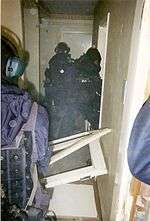Specialist firearms officer
A specialist firearms officer (SFO) is a British police officer who has undergone training in the use of police firearms to a more advanced level than authorised firearms officers (AFOs). SFOs receive additional training in areas such as building assault and specialist weapon usage. The common role of an SFO is to assault premises involved in a siege situation, effect high-risk firearms related arrests and respond to terrorist threats.[1][2]
In 2012, a higher-qualification, known as Counter Terrorist Specialist Firearms Officer (CTSFO) was established by the Metropolitan Police Service prior to the 2012 Summer Olympics with other police forces, including Thames Valley Police, West Yorkshire Police, West Midlands Police, Strathclyde Police and Greater Manchester Police trained in this qualification to assist the MPS with the Olympics.[3][4] The MPS has replaced the SFO qualification with CT-SFO.[5]
Legal status of the use of firearms

The usage of firearms by the police is covered by statute (such as the Police and Criminal Evidence Act 1984 and Human Rights Act 1998), policy (such as the Home Office Code of Practice on Police use of Firearms and Less Lethal Weapons and the ACPO Manual of Guidance on Police Use of Firearms) and common law.
United Kingdom law allows the use of "reasonable force" in order to make an arrest or prevent a crime[6][7] or to defend one's self.[8] However, if the force used is fatal, then the European Convention of Human Rights only allows "the use of force which is no more than absolutely necessary".[9] Firearms officers may therefore only discharge their weapons "to stop an imminent threat to life".[10]
ACPO policy states that "use" of a firearm includes both pointing it at a person and discharging it (whether accidentally, negligently or on purpose).[11] As with all use of force in England and Wales, the onus is on the individual officer to justify their actions in court.[12]
Training
Potential SFOs receive extensive training in:
- Safe use of specialist firearms
- Method of entry techniques to gain access to premises quickly
- Abseiling and 'fast rope' skills
- Scenario training (such as being instructed to search a specially adapted training area of an aircraft)
- Use of tear gas and stun grenades
- Hostage rescue and handling techniques,
- Computer simulated 'war games' of potential threats, such as terrorist attacks
- The use of protective clothing against CBRN attack
Weapons used
Non lethal: 37mm Baton gun, X26 Taser (stun gun). Standard UK police equipment
References
- Morris, Steven (2004-11-04). "By the book: how force trains its firearms unit". The Guardian. London. Retrieved 2010-05-23.
- http://www.devon-cornwall.police.uk/v3/about/departm/codiv/operdept/ou.htm
- "Tony Morgan CV" (PDF). Cops on Film & TV. Retrieved 23 March 2017.
- "Performance Review Committee" (PDF). Thames Valley Police Authority. 2 October 2012. Archived from the original (PDF) on 9 June 2015.
- "Various questions inrelation to becoming an Armed Response Vehicle (ARV) officer - Freedom of Information Request" (PDF). Metropolitan Police Service. 4 March 2016. Retrieved 29 March 2017.
- Police and Criminal Evidence Act 1984, Section 117 or Police and Criminal Evidence (Northern Ireland) Order 1989, Article 88
- Criminal Law Act 1967, Section 3 or Criminal Law Act (Northern Ireland) 1967, Section 3
- Common Law, as cited in ACPO (2003), Manual of Guidance on Police Use of Firearms, 2.3.4 Archived 2008-04-13 at the Wayback Machine
- ACPO (2003), Manual of Guidance on Police Use of Firearms, 2.3.7 Archived 2008-04-13 at the Wayback Machine
- ACPO (2003), Manual of Guidance on Police Use of Firearms, 5.6.1 Archived 2008-04-13 at the Wayback Machine
- ACPO (2003), Manual of Guidance on Police Use of Firearms 3.2.4 Archived 2008-04-13 at the Wayback Machine
- ACPO (2003), Manual of Guidance on Police Use of Firearms Chapter 3.3.1 Archived 2008-04-13 at the Wayback Machine